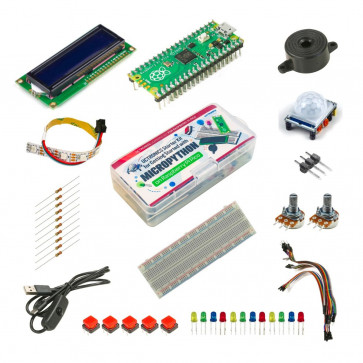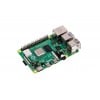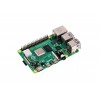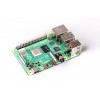Sie haben keine Artikel im Warenkorb.
Raspberry Pi Pico Starter Kit w/ Breadboard, LED, Jumper Wire, LED, Motion Sensor Display
Raspberry Pi Pico Starter Kit w/ Breadboard, LED, Jumper Wire, LED, Motion Sensor Display & More
Artikelnummer:
11582
Delivery Time: ab Lager
Verfügbarkeit: Sofort-Versand ab Lager
CHF 58.90
Artikelbeschrieb
Details
A basic starter kit inspired by the Raspberry Pi Pico Guide. You can either build quick projects with the official book or create your own using dozens of components (see below).
Features
- Beginner-friendly tutorial book with codes.
- Great for both first-time Pico users and kids.
- Full SDK and datasheet references for experienced developers.
- Compatible with any of your favorite platforms and operating systems.
Things you can make
- Traffic light controller.
- Reaction game.
- Burglar alarm w/ motion sensor and buzzer.
- Temprature monitoring.
- Using an I2C or SPI display.
Parts & Components
- 1 × Raspberry Pi Pico with male headers attached.
- 1 × Solderless breadboard.
- 30 × Jumper wires: 10pcs each of male-to-female (M2F), male-to-male (M2M), and female-to-female (F2F).
- 5 × Push-button switches.
- 12 × Colorful LEDs: 3pcs each of red, blue, yellow, and green.
- 10 × 330 Ω resistors.
- 1 × Active piezoelectric buzzer.
- 2 × 10 kΩ potentiometer.
- 1 × HC-SR501 PIR sensor.
- 1 × I2C 1602 LCD module.
- 1 × WS2812B LED strip.
- 1 × Spare header.
- 1 × Micro USB cable with a switch button.
- 1 × Clear packing box.
Note: Raspberry Pi is not included.
Specifications of Pico
- 21 mm × 51 mm form factor
- RP2040 microcontroller chip designed by Raspberry Pi in the UK
- Dual-core Arm Cortex-M0+ processor, flexible clock running up to 133 MHz
- 264KB on-chip SRAM
- 2MB on-board QSPI Flash
- 26 multifunction GPIO pins, including 3 analogue inputs
- 2 × UART, 2 × SPI controllers, 2 × I2C controllers, 16 × PWM channels
- 1 × USB 1.1 controller and PHY, with host and device support
- 8 × Programmable I/O (PIO) state machines for custom peripheral support
- Supported input power 1.8–5.5V DC
- Operating temperature -20°C to +85°C
- Castellated module allows soldering direct to carrier boards
- Drag-and-drop programming using mass storage over USB
- Low-power sleep and dormant modes
- Accurate on-chip clock
- Temperature sensor
- Accelerated integer and floating-point libraries on-chip
Documents
- Getting Started with MicroPython on Rpi Pico
- C/C++ Development w/ Pico and RP2040-based Boards
- Raspberry Pi Pico Datasheet
- RP2040 Datasheet
- RPi Pico C/C++ SDK
- RPi Pico Python SDK
- API references













